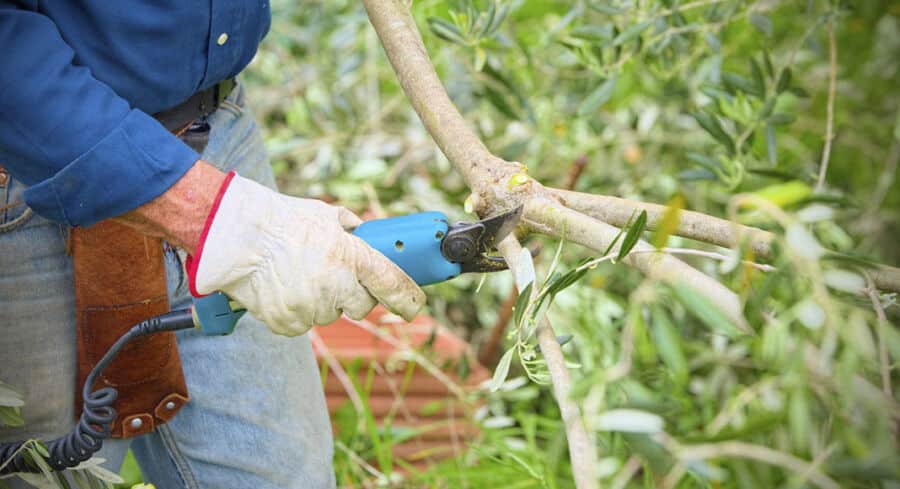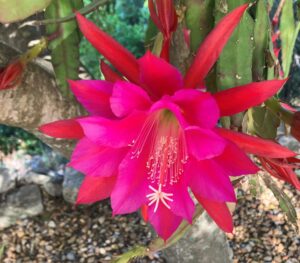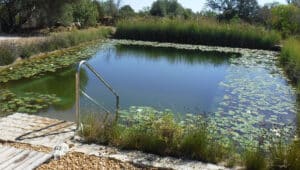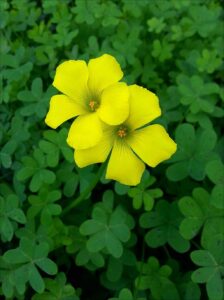Many gardeners in the Algarve have olive trees on their land and wish to have a go at doing their own pruning of these iconic trees. If you have a few trees, then this can be a very satisfying and pleasing activity. On the other hand, if you have commercial size plantations, the pruning may best be left to professionals.
Pruning is rightly considered to be the major cultural practice in any orchard. Pruning adjusts the tree to the specific climatic and soil conditions of the area and increases the productivity of the orchard.
The main aims of pruning are summarised below:
▪ to give the tree the best shape in relation to soil and climate conditions
▪ to balance the vegetation with the fruit yield
▪ to minimise the non-bearing period
▪ to prolong the productivity of the orchard
▪ to delay senescence (ageing)
There are three main types of pruning:
1. pruning during the early stages of the tree’s growth
2. pruning for fruiting
3. rejuvenation pruning
1. Pruning during the early stages of the tree’s growth
The aim of this type of pruning is to develop a tree shape during the first years after planting that will help the tree (spraying, soil cultivation, irrigation, harvesting etc) and will enable the tree to best exploit the sunlight and rainfall.
The most common shape for the olive tree is the “cup-shaped” tree or “goblet”. To form this shape, the newly-planted one-year-old trees are cut back to a height of approximately 60-80cm above soil level. The main aim of such a practice is to force 2-4 side branches to develop around the axis of the tree, at a distance of 30-40cm from each other and at a height of approximately 40cm (the first) to 80cm from the ground. These branches should in future comprise the main branches (primary limbs) of the tree.
On these branches new side shoots will be encouraged by cutting the old branches to a length of approximately 50cm, thus removing the so-called shoot tip dominance and making the lower buds sprout.
There are many tree shapes that are used around the world, but in the Algarve the ‘open goblet’ style of selecting four or five branches seems to be the norm.
2. Pruning for fruiting
Olive trees produce fruit on the previous year’s branches. This means that in order to have fruit we must ensure adequate vegetative growth every year. Very vigorous shoots are not productive, as they are mostly full of leaf and not flower buds. The aim of pruning is thus to induce branches that will bear fruit by exposing them to the light and maintaining a vigorous and active fruiting zone.
The olive tree produces fruit mainly at the edge and top of the canopy. This is because these parts of the tree are fully exposed to sunlight and become fertile. Pruning for fruit should consist of the removal of any part that shades other younger parts of the tree. A branch which has fruited can be cut down during the following year in order for the upper branch to bear fruit. In this way, the branch is not led away from the central axis of the tree.
When a thick branch is to be cut off, we must take great care to avoid tearing the bark of the remaining branch. This is usually done by making a total of three cuts. The first cut is made from the lower side of the branch to the middle of it, some centimetres away from the point where we want to cut the branch. The second cut is made a few centimetres away from the first cut and usually before the completion of this cut; due to the weight of the branch, it will fall, tearing the bark of the remaining branch to the point where the first cut was made. We can then easily cut off the small remaining part, to the point desired.
3. Rejuvenation pruning
The main characteristic of the olive tree is its longevity, resulting from its ability to produce new shoots from nearly every part of the wood, thus making it possible to renovate old trees or those that have been damaged by frost or fire. This type of pruning involves cutting the tree at the main branches or even at the trunk. The most significant practice, however, is to return during the next months and remove by hand (when they are still young) the shoots that will be of no use to us. We should not wait until the following year to give the tree the shape we desire, as this would waste almost an entire year before the beginning of fruit production. The new tree enters its fruiting period after 3-5 years, depending on the cultural practices used.
After any pruning or cutting, cover the wounds with wound-sealing pastes and spray the trees with a fungicide, in order to prevent the tree from developing bacterial or fungal infections. The pruning of olive trees can be done during the period between autumn and winter. It is generally performed after the harvest, but we should wait until the period of heavy rains or frost has passed to prevent infections. We should never prune on a rainy day, as this will probably spread bacteria to the cut surfaces or to internal wounds invisible to the naked eye, resulting in possible bacterial canker of the living tree.
It has become a common practice to see olive trees of all ages dug up and prepared for transplanting into our gardens. Never irrigate close to the trunk and never mulch with pine bark or other fungus inducing materials. You will find that a newly transplanted tree will need infrequent and deep irrigation (once a month during the summer) to promote new secondary root production.
After the first year or two, remove irrigation completely. Also, we should note that the critical phases for water stress in commercial olive trees are late spring and early summer – principally the periods before and after flowering (during fruit set), when drought can result in a significant reduction in the flowering and thus the fruit set, leading to low production.
The olive gives mediterranean gardens their own special signature tree and it is up to you whether you wish to have their ornamental contribution, or to maximise fruit production. It is well worth making a visit to the organic olive grove and mill near to Moncarapacho – https://www.monterosa-oliveoil.com/en/
With grateful thanks to Dr. Peter A. Roussos, Agricultural University of Athens, Greece.
By Rosie Peddle
|| features@algarveresident.com
289 791 869 | mgapsec@gmail.com
www.mgaportugal.org































